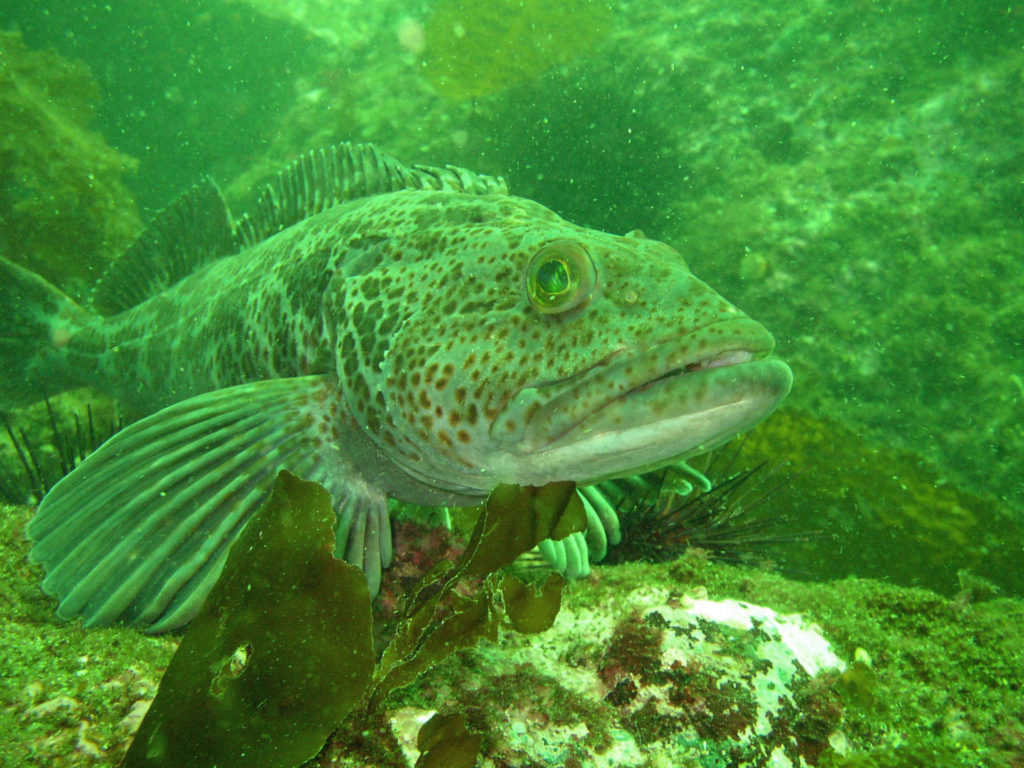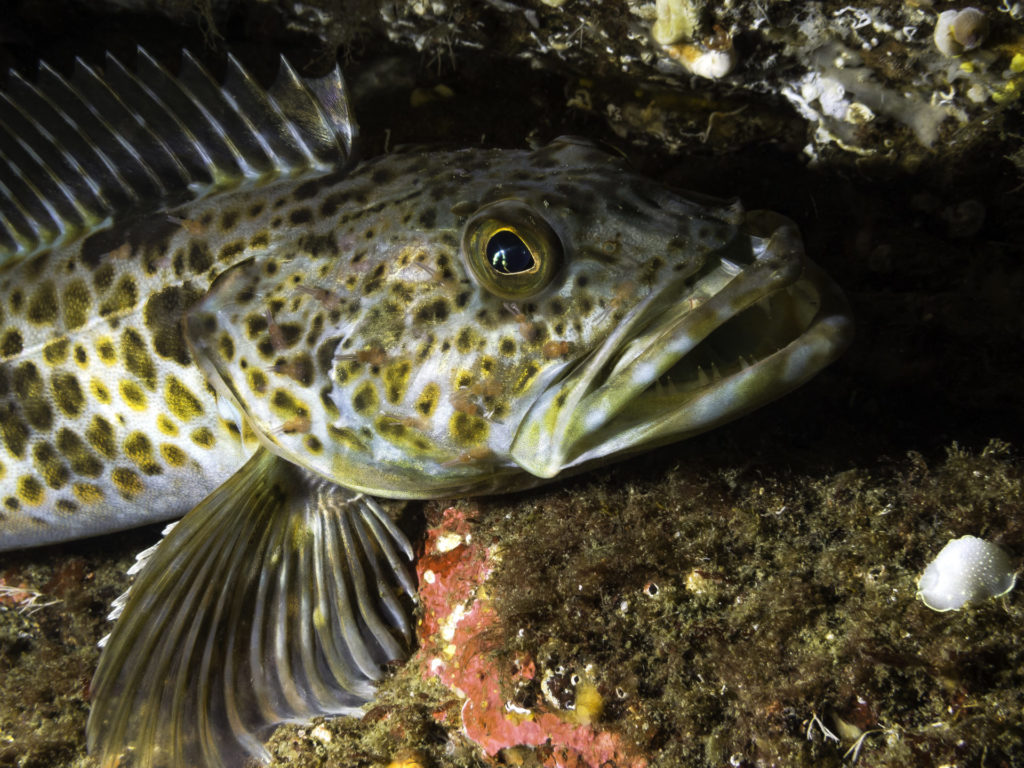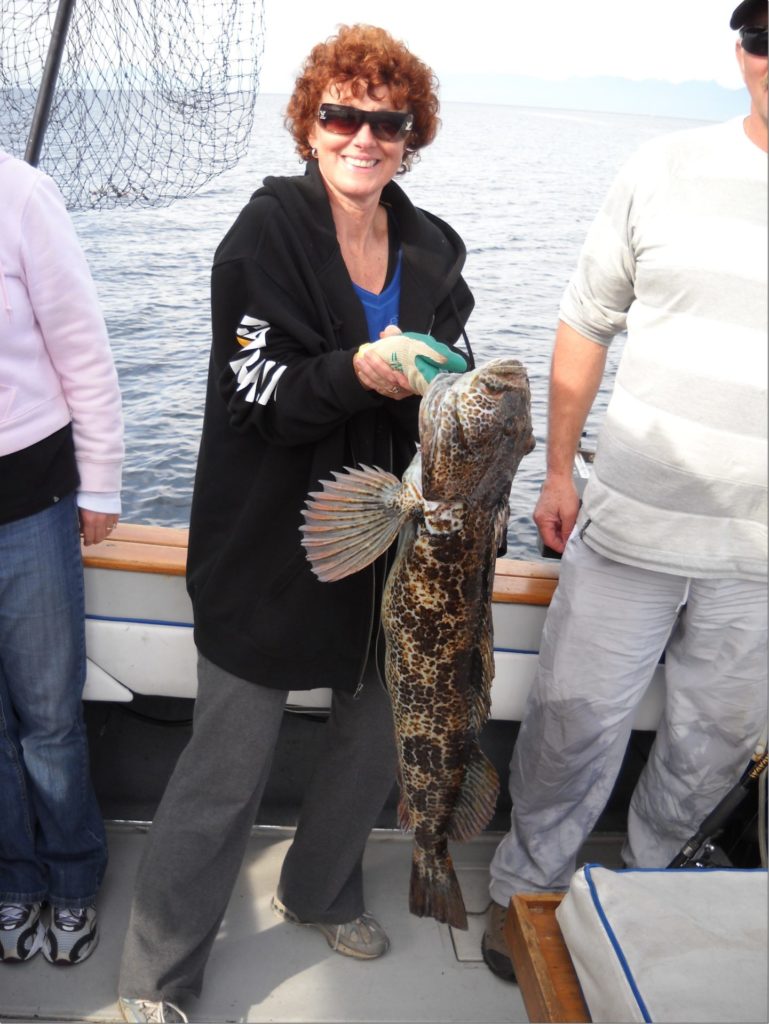Lingcod Background
The lingcod is not actually a true cod; it belongs to a group of fishes known as greenlings, of which there are five varieties in BC waters. For years they have worn the catch-all cod name, along with other reef and bottom dwellers that have been similarly misnamed. Rock cod is a well-known example of another improperly named group of fishes. The correct name is rockfish and they are part of a large and widely dispersed family of scorpion fishes. True cod, which include grey cod and hake, are not reef dwellers, but schooling fish most often found in open water.
Advertisement

Lingcod ancestry dates back 25 million years, so they’ve had a long time to evolve into apex predators. Armed with wicked teeth, a massive mouth, big eyes, bursts of speed and impressive size, they can tackle a variety of prey species. Females can reach a metre in length and weight up to 30 kilograms. The males are smaller, but still formidable creatures. They are also a long-lived fish, with females reaching 15 to 20 years, or about five to six years longer than the males. Their varied skin colour is perfectly suited for an ambush predator living in a craggy reef environment. Most have cream to white underbellies, but the sides and backs can be quite different. Common skin colours include patchy blotches of black, blue, brown to bluish green and even touches of orange. They prey on passing schools of herring and other bait fish, but are not averse to snatching an unwary rockfish, salmon or similar-sized meal if it fits inside that cavernous mouth.
They were officially identified in BC waters in 1881 by Jordan and Gilbert, who recorded a specimen near Victoria. However, for thousands of years they were always an important source of food for First Nations. They are arguably one of, if not the best eating fish on the Pacific coast, and that characteristic inevitably led to overfishing. Early coastal settlers fished for lings for sustenance. However, by the 1900s, a small, commercial hook-and-line fishery existed in the southern portion of Georgia Strait. Commercial operations soon expanded northwards and up the west coast of Vancouver Island, while at the same time catching efficiency rapidly increased as participants switched from hook-and-line operations to trawling. Overharvesting afflicted all early coastal fishing activities. It was this catch-to-the-max mindset that led to stock declines. The problem was magnified because regulations didn’t keep pace with new fishing technology and capacity. By the late 1960s, it had developed into a booming commercial operation with catches exceeding 12 million pounds in 1968. A decade later, stocks were in decline, forcing Fisheries to close the commercial harvests in Georgia Strait in the 1990s, while putting significant catch limits on the much smaller recreational fishery. Because these stocks take time to recover, conservation-based angling regulations are still in place. However, even with modest limits, lingcod remain an important component of the overall sport fishing experience.
Advertisement
In the late 1940s and early 1950s, my dad commercially fished lingcod from a small, 16-foot open boat. His favourite tactic was to take cod skins and slow troll them over his favourite lingcod haunts. He used landmark bearings to inventory cod reefs around the northern end of the Saanich Peninsula and the southern Gulf Islands. He committed these landmarks to memory and passed some of them down to me. I later overlaid those landmarks on my charts, which I still have to this day. GSP made the visual bearing system obsolete and, in doing so, probably increased angling pressure because good ground was easier to find. My first experience with lingcod and other bottom fish came before I was old enough to go to school. My father used to test his fishing lures on a small mooring dock at the old Swartz Bay ferry wharf. I’d often go with him, as it was only a short walk from our house in North Saanich. The Newmans from Sansum Narrows were live cod fishermen and they’d occasionally tie up at the same dock. As a treat, they’d remove the hatch covering the live cod well and let me watch the lingcod and rockfish swim around the tank. They looked pretty impressive to a four or five-year-old kid and they fascinated me.

Lingcod Tactics
Look for structure like reefs, pinnacles, points of land with good current flow and fairly steep drop-offs on as many sides as possible. Large underwater plateaus and banks are also good habitat, as long as there are some steeper drop-offs on at least two sides. Lings can be fished from quite shallow water to hundreds of feet deep, and fishing should be done during slow current flows. Keep in mind that the deeper you fish, the heavier your tackle needs to be. If you are fishing down the sides of structure, begin at the shallowest point. Drift with the current, from the top of the structure down the side of the reef. Make sure you periodically let out a bit more line to make contact with reef, then quickly reel in a few feet and start jigging. You can vary the jigging motion from a short, sharp twitch of the rod tip to a longer, slower pull. After a minute or so, reconnect with the side of the reef and repeat the process. I call this stepping down the ladder, or in this case down the side of the reef. When the current moves you off the reef to the sea floor, motor back to the top, move to a slightly different location and repeat the drift. I learned this tactic while fishing the waters around Sidney, where most of the good ling ground consisted of underwater pinnacles and kelp-strewn reefs. However, when Bob Meyer, who is an expert fishing guide and owner of Silver Blue Charters on Gabriola Island, invited me to fish for lingcod, he concentrated on the relatively shallow plateaus that surround Thrasher Rock. This area is one of the Strait’s most productive lingcod locations and our time there did not disappoint. Bob let the current move us slowly across the plateau. We used whole herring, which we occasionally activated with periodic pulls on the rod.
Advertisement
Anglers can also shore cast for lingcod using spinning reels, smaller jigs and medium-action rods. Just look for a tide-swept area with lots of kelp and a steep drop-off. However, when casting from shore you’ll have to start retrieving the lure well before it gets near the surface kelp and the drop off or you’ll risk a troubling hang up.
Lingcod Tackle
You can take lingcod on a lot of different gear. Mature males are very aggressive when guarding the nests in late winter and early spring. These fish have to be released as the season is closed, and for good reason. Once the males are removed from the nest, the eggs or newly born lings are unprotected from every other predator that lives on the reef.
Lead jigs that are either jigged from a boat or cast from shore are very popular. These can be fished, as they are or tipped with pieces or herring or other natural baits. Whole herring are great lingcod baits. I would opt for bigger lures and baits in the hope the size of the bait might discourage smaller reef dwellers from taking that first shot at it. So bigger conventional jigs, or larger lead jigs with an upward-facing hook and a swimmer tail plastic skirt can be really effective. The up-hook style offers the added bonus of being virtually snag free because of the hook position.
Jig colours should be bright because these are sight-dependant predators. If you are going to use whole herring, fix a three-way swivel to the end of your line and run about 18 to 24 inches of leader to your herring. Then hang a pound of weight facing downward off the swivel. If you fish deep, increase the weight size accordingly.
A standard medium-action, 10-foot salmon rod is adequate for lingcod, although going to a slightly heavier version might be needed once you fish beyond 120 feet. Star drag multiplier reels are a must, as is low or non-stretch, abrasive resistant fluorocarbon or braided fishing line. My old faithful bottom fishing set up is a 10.5-foot, medium stiff graphite rod with a Daiwa Sea Line 47H reel, loaded with 80-pound Dacron line. Do not use standard monofilament. If you do use it and get your lure hung up, you might not realize the gear is stuck until it’s too late, because once stuck it’s almost impossible to free up. Past a certain depth, monoline does not transmit the jigging action to the lure effectively. Furthermore, it won’t give you instant contact with the fish, giving it time to dive into the nearest rocky crevice. This complicates getting the fish to the surface.

Lingcod & Rockfish Conservation
Both are relatively long-lived species with low reproduction rates, so it takes a long time for them to recover from abundance downturns. Here are a few tips to protect both lingcod and rockfish from unintended angling mortalities:
- Release bigger lingcod. These are likely all females, which are critical for stock recovery. The smaller fish are mainly males. (Voluntary)
- Know where Rockfish Conservation Areas are located, and don’t fish there. (Required)
- Know and abide by daily and possession bag limits and closed fishing periods. (Required)
Lingcod do not suffer from the bends like most rockfish species. However, you’ll likely hook a number of rockfish while angling for lingcod, so it’s in the best interest of conservation if you purchase a rockfish descending device. This tool improves rockfish release survival significantly and they can be found at most tackle shops.